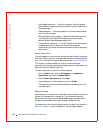
Microsoft® Windows® XP Features 255
When you select Switch User, the main user Welcome screen appears. You
can then select your account name and log in. Your personal desktop
appears.
What Happens When a Fast User Switch Occurs?
When a fast user switch occurs, the original user is not logged off the
computer as previously happened on other Microsoft operating systems. On
Windows XP, the user's logon remains active, but is replaced by the new
user. Users can switch between login IDs as often as they want.
However, user applications active during a user switch remain active and
running in the background while the new user is working; this can result in a
slower computer until the process finishes. For example, if one user is
downloading a large file from the Internet and another user logs on to the
computer, the file download continues in the background until it is
complete.
While most applications continue to run in the background during a fast
user switch, multimedia applications do not. Because multimedia
applications use resources that cannot easily be shared between different
users on a single computer, those applications terminate during the user
switch, allowing the new user to take full advantage of the multimedia
capabilities.
Special Considerations With Fast User Switching
Considerations when using Fast User Switching include:
• Some older Windows games may not operate with a fast user switch.
• Multimedia games may shut down on a fast user switch.
• DVD software shuts down and requires a restart when the user comes
back.
• Computers with low memory configurations can experience problems.
The computer uses memory to keep the first user's programs running
in the background while the second user is logged on. On computers
with limited memory, this can cause the entire computer to run slowly.
Fast User Switching is off by default on computers with less than
128 megabytes (MB) of random-access memory (RAM).


















